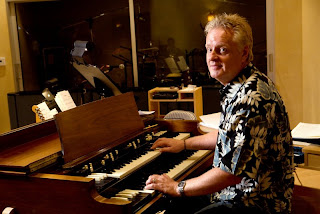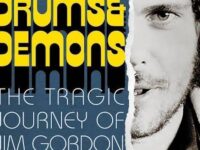I’ve often wondered what a record made by a couple of guys who’ve made a distinguished living scoring films, TV shows, even CD ROM education games would sound like. Actually, I haven’t, but with yesterday’s release of Dave Siebels with Gordon Goodwin’s Big Phat Band, I’ve got my answer, anyway.
Dave Siebels is a Hammond B3 Organ player on this record, but “jazz organist” probably isn’t listed on the very top of his resumé. Not with all the work he’s done as a composer, arranger and record producer (including Pat Boone’s notorious In A Metal Mood record), scoring 9 TV series and 35 films, arranging/producing 27 albums and conducting for 65 musical variety TV shows.
Keyboardist and sax player Gordon Goodwin has done his fair share of film work, too, winning a Grammy and an Emmy for his efforts along the way. This has been a major part of his endeavors for the last twenty years or so, but more recently, his labor of love has been in the form of leading and arranging for a large ensemble he formed, the Big Phat Band. With five albums since 2001, Goodwin has gained acclaim again, only in a more visible way.
When Siebels himself finally decided he wanted to make a record for himself—a big band record—he saved himself the time and effort of putting together a big band and instead borrowed the hottest big band today, i.e., Goodwin’s Big Phat Band.
OK, so saying “the hottest big band today” doesn’t hold the same sway that it did in 1937, but somebody’s gotta be on top, and right now that would be Goodwin’s outfit. Besides, the Phat Band includes or has included amongst its members the likes of Eric Marienthal, Grant Geissman, Gary Grant and Jerry Hay and guests ranging from Eddie Daniels, Johnny Mathis and Arturo Sandoval to Dianne Reeves, David Sanborn and Chick Corea. If you can judge the quality of a big band by the company it keeps, the Big Phat Band has no peer in the digital age. Aside from that, the Phat Band isn’t an old-timey swing band; Goodwin keeps his material fresh and with a contemporary feel, while maintaining imaginative arrangements.
Now I’m a sucker for B-3 grooves but putting one in front of a eighteen players means it isn’t going to be the greased-up gospel soul of Jimmy Smith, and honestly, the Smith route has been rather well-traveled. By partnering with Goodwin’s crew, Siebel gets to forge more of his own path. Siebels as an organist is plenty competent; he won’t make too many the blazing runs of a Joey DeFrancesco but prefers a more relaxed burn of a Richard ‘Groove’ Holmes or sometimes Charles Earland.
Ultimately though, the success of this record depends on Goodwin’s and Siebel’s arrangement skills and that’s where the record makes its mark. Goodwin’s arrangement on the swinging Siebels original “The Coupe” is spot-on with his attention toward putting the horns in the little pockets of grooves and well-placed accents that give Siebels plenty of room to breathe. “Not That There’s Anything Wrong With That” is a rockin’ shuffle that has the horns play the single note lines right along with Siebel.
Even though Neil Hefti’s “Girl Talk” is just organ/guitar/drums and is one of the handful of softer cuts on this mostly sizzling affair, it’s also one of the best. Geissman does some fine comping against Siebel’s intensely soulful organ and solos beautifully as well. The Big Phat Band largely sits out of another ballad, Siebel’s own gentle “I Love You Even More Again,” which highlights the trumpet of Roy Wiegand (which I originally thought was a synthesizer, it was played with such an absence of brassiness).
“I Wish” is another cover, but this Stevie Wonder hit provides an opportunity for Goodwin to take this well-known tune and make it sound refreshed again. After an intro built from a riff taken from the middle of the song, the theme is expressed in a recognizable form, but not too much so. It’s just as funky as the original, yet in an almost entirely different way.
Keeping it mixed up, a boogaloo in the form of Lalo Schifrin’s “The Cat” is served up, followed by the self-explanatory “Sort Of Like A Samba.” The record ends with another solid funk number “The Eleventh Hour,” where Goodwin himself blows on tenor sax.
Making a groove record with a big band at first blush seems almost incompatible; too many musicians can spoil that groove. But Siebels and Goodwin make it work so that the Big Phat Band enhances Siebels’ organ and songs, and never really getting in the way of either. That’s what makes Dave Siebels with Gordon Goodwin’s Big Phat Band not just a good idea for a B-3 record, but a good idea realized.
- How Norah Jones Continued to Push Against Convention With ‘The Fall’ - November 23, 2024
- McCoy Tyner and Joe Henderson – ‘Forces of Nature: Live at Slugs’ (2024) - November 21, 2024
- Lydia Salnikova, “Christmas Means a Different Thing This Year” (2024): One Track Mind - November 19, 2024





